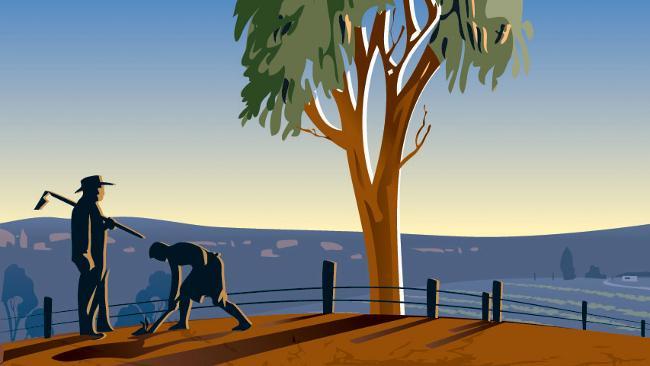Figures in a subtle landscape
THE first thing to impress the reader of The Vintage and the Gleaning, Jeremy Chambers's debut novel, is its air of calm restraint.

THE first thing to impress the reader of The Vintage and the Gleaning, Jeremy Chambers's debut novel, is its air of calm restraint.
Its opening is simplicity itself: one kelpie bitch, two utes and three men who swap droll banter as they sharpen worn shovels to a fine edge for use in the vineyards that extend in countless rows around them.
It is early Monday morning somewhere outside a small winemaking town in Victoria's northeast -- the sort of place that boasts several pubs and streets so wide they cast Russell Drysdale-like shadows at each end of the day -- though much of this information is only divulged later on. For now we learn about a local man's death of a heart attack on the weekend: intelligence relayed in a manner halfway between the clipped, laconic exchanges favoured by Australia's country folk and the syncopated repetitions of a Beckett play.
This chamber-piece beginning is worth dwelling on because it provides a neat introduction to the author's method. The casual amorality of the men's exchange (the circumstances surrounding the death are joked about; the dead man's widow is declared fair game) is partly neutralised by the artfulness of its unfolding. And the conversation's harsh edges are softened by its exquisite frame:
The old ghost gum in the next paddock catches the light and it catches it high up so that high up the foliage is rimmed with gold and it sways slightly and the leaves move all together, the branches smooth and white with swollen folds like loose, swaying, barely swaying, but in the light the movement seems beautiful.
The one doing the subtle noticing here is our narrator, Smithy, a retired shearer now working as a day labourer on local vineyards. Outwardly Smithy is as curtly indifferent as his colleagues: Roy, a portly Lothario, and Wallace, the hard-drinking overseer of their work-gang. Only we are privy to his inward eye and the naive poetry of its gaze.
Smithy's past and present circumstances are doled out frugally in these early sections. He lives alone. He is old, but not elderly. His health is broken, however, and he now lives off the dregs of his once formidable stamina and physical strength. His apprehension of the beauty of which the world is capable is a new discovery after a lifetime of keeping tight focus on the task at hand, and is a tribute to Chambers's skill that he manages to infuse Smithy's belated awakening with an elegance that does not exceed the man's limited expressive means.
In fact, both author and narrator practise an uncommon abstinence here. Smithy is the product of another Australia: a country defined by its rural character and mores, run by large pastoral companies and wealthy graziers who rode high on the sheep's back. It was a rigid, masculine society, stratified by skin colour, class and gender; a culture in which long stretches of sober industriousness were punctuated by intense binges of brawling and booze.
Smithy, then, is old school: a superfluous man alert to declinations from old rural ideals. And it is through him that we witness the fall of its landholding elite. As he walks through the farmyard of an employer known only as the Boss, for instance, Smithy sees the old wine-presses of cast iron and cracked wood, ploughs and yokes of rusted rims, machines with forgotten purpose:
Past Boss's Father's stables, full of saddles turning to powder, mice nesting in blankets and uniforms, his dress-sword the old .303 gone to pieces and nothing left of the medals but the medals themselves, scattered among the rodent droppings, tarnished green and black and beyond recognition.
Just as the descendants of the old Boss's thoroughbreds have gone brumby, younger generations of rural workers have turned feral. The town's bars are filled with those whose prospects went the same way as their employers' properties. Smithy's adult son, a thoughtless laggard known only as Spit, spends his days drinking and fishing on the local river, skiving work and avoiding his young wife and children. But Spit's low-life drinking companions are up to worse.
The central drama of The Vintage and the Gleaning arises from a clash between this older rural world -- with its narrowness, its inflexibility and its stubborn pride -- and the more assertive, urbanised and jaded youth that represent its future. In the past, Smithy has shown kindness to Charlotte, an attractive young woman married to a local thug who is set to be freed from jail, an incarceration he earned for domestic violence. When the old shearer invites the frightened young woman to stay at his house, it is a gesture inspired by a mixture of gallantry, loneliness, self-sacrifice and residual male vanity. Of course, the fact of her dangerous presence serves to disturb Smithy's equanimity. Just as she galvanises his senses in the present, Charlotte's proximity awakens his memories of the past.
At which point, it should be said, The Vintage and the Gleaning becomes a quite different novel. The narrative is suspended while Smithy and Charlotte are given space to offer extended monologues, sketching the choices that led them to this point. Chambers takes care to balance these accounts, making each rhyme with the other: Charlotte, the middle-class girl who embraced the town rough as means of hurting her farmer-father; and Smithy, the hard man who inhabited the blokeish role laid out for him with such vigour that he lost his wife and son.
These pages flow beautifully: they are as naked in exposure as those that preceded them were zipped tight.
But there is a price to pay for suspending the narrative. The suspense that sustained the tale drains away. And the climax, when it comes, feels like a something gone through for the sake of ending rather than urgent catharsis.
Perhaps, though, this is part of the point Chambers is making. Maybe the bathos with which the novel ends is another aspect of his restraint, his unwillingness to jump through the usual narrative hoops.
Whatever the case, The Vintage and the Gleaning represents a rich, complex exploration not just of the inner worlds of two lost souls but also of the society from which they come and the landscape through which they move.
Sometimes eerie like Kenneth Cook's Wake in Fright, just as often celebratory of landscape in the spirit of Randolph Stow or Patrick White, Chambers's first novel has a certain rhythm, a pure, lovely voice, and a sense of contemporary disquiet that is his alone.
Geordie Williamson is chief literary critic of The Australian. He has worked as a viticultural labourer and roustabout.



